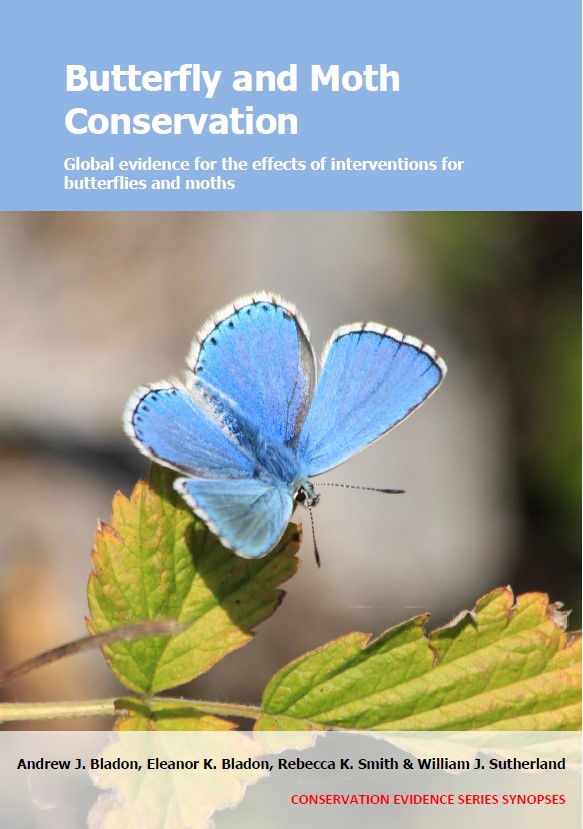Actions to conserve biodiversity
We have summarised evidence from the scientific literature about the effects of actions to conserve wildlife and ecosystems.
Review the evidence from the studies
Not sure what Actions are? Read a brief description.
Search for evidence
e.g. "frogs chytrid"
152 Actions found
Refine
Hide
152 Actions found
Download Actions
| 0 selected |
|
Order results by:
| Action | Effectiveness | Studies | Category | |
|---|---|---|---|---|
|
Pay farmers to cover the costs of conservation measures (as in agri-environment schemes or conservation incentives) Action Link |
Evidence not assessed | 32 |
|
|
|
Cease grazing on grassland to allow early succession Action Link |
Evidence not assessed | 26 |
|
|
|
Plant grass buffer strips/margins around arable or pasture fields Action Link |
No evidence found (no assessment) | 26 |
|
|
|
Plant nectar flower mixture/wildflower strips Action Link |
Evidence not assessed | 23 |
|
|
|
Rear declining species in captivity Action Link |
Evidence not assessed | 22 |
|
|
|
Maintain species-rich, semi-natural grassland Action Link |
Awaiting assessment | 19 |
|
|
|
Use rotational burning Action Link |
Evidence not assessed | 17 |
|
|
|
Manage hedgerows to benefit wildlife (e.g. no spray, gap-filling and laying) Action Link |
Evidence not assessed | 17 |
|
|
|
Translocate to re-establish populations in known or believed former range Action Link |
Evidence not assessed | 16 |
|
|
|
Cease mowing on grassland to allow early succession Action Link |
Evidence not assessed | 16 |
|
|
|
Clear or open patches in forests Action Link |
Evidence not assessed | 14 |
|
|
|
Reduce grazing intensity on grassland by reducing stocking density Action Link |
Evidence not assessed | 14 |
|
|
|
Use prescribed fire to maintain or restore disturbance in grasslands or other open habitats Action Link |
Evidence not assessed | 13 |
|
|
|
Convert to organic farming Action Link |
Evidence not assessed | 13 |
|
|
|
Release captive-bred individuals to the wild Action Link |
Evidence not assessed | 13 |
|
|
|
Increase or maintain the proportion of natural or semi‐natural habitat in the farmed landscape Action Link |
Evidence not assessed | 12 |
|
|
|
Reduce management intensity on permanent grasslands (several interventions at once) Action Link |
Awaiting assessment | 12 |
|
|
|
Reduce fertilizer, pesticide or herbicide use generally Action Link |
Evidence not assessed | 11 |
|
|
|
Replant native vegetation Action Link |
Awaiting assessment | 11 |
|
|
|
Legally protect habitat Action Link |
Evidence not assessed | 10 |
|
|
|
Remove, control or exclude vertebrate herbivores Action Link |
Awaiting assessment | 10 |
|
|
|
Restore arable land to permanent grassland Action Link |
Awaiting assessment | 10 |
|
|
|
Restore or create forest or woodland Action Link |
Evidence not assessed | 10 |
|
|
|
Coppice woodland Action Link |
Evidence not assessed | 10 |
|
|
|
Use rotational mowing Action Link |
Awaiting assessment | 10 |
|
Download Actions
| 0 selected |
|

Butterfly and Moth Conservation - Published 2023
Butterfly and Moth Synopsis
Watch this search
If you are familiar with RSS feeds, please click the button below to retrieve the feed URL:
RSS feed for this searchIf you are unfamiliar with RSS feeds, we would suggest reading this BBC article.
Unfortunately, due to the number of feeds we have available, we cannot provide e-mail updates. However, you could use tools such as Feed My Inbox to do this for you.
What are 'Individual studies' and 'Actions'?
Individual studies
An individual study is a summary of a specific scientific study, usually taken from a scientific journal, but also from other resources such as reports. It tells you the background context, the action(s) taken and their consequences.
If you want more detail please look at the original reference.
Actions
Each action page focuses on a particular action you could take to benefit wildlife or ecosystems.
It contains brief (150-200 word) descriptions of relevant studies (context, action(s) taken and their consequences) and one or more key messages.
Key messages show the extent and main conclusions of the available evidence. Using links within key messages, you can look at the paragraphs describing each study to get more detail. Each paragraph allows you to assess the quality of the evidence and how relevant it is to your situation.
Where we found no evidence, we have been unable to assess whether or not an intervention is effective or has any harmful impacts.





)_2023.JPG)














